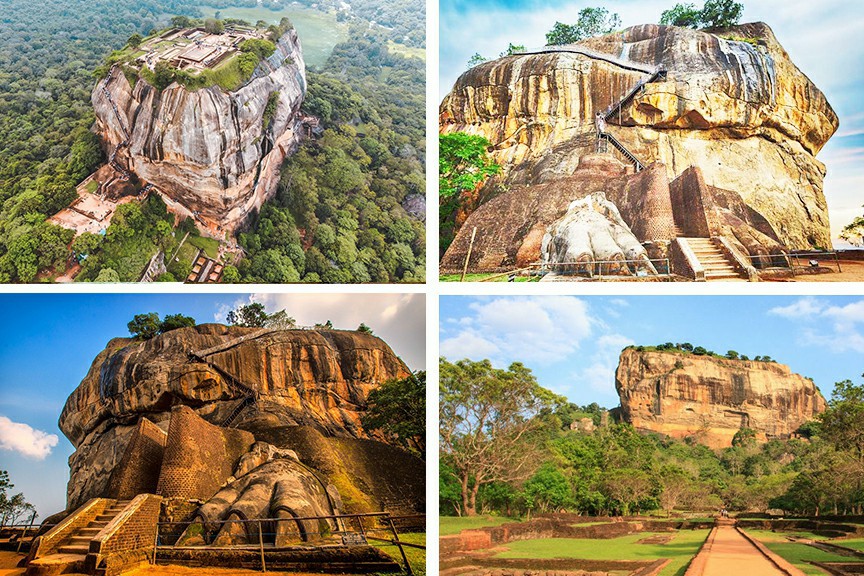Sigiriya Fortress
Popular myth says that the formation served royal and military functions during the reign of King Kassapa (AD 477–495), who allegedly built a garden and palace on the summit. According to this theory, King Kassapa sought out an unassailable new residence after overthrowing and murdering his own father, King Dhatusena of Anuradhapura.
A new theory, supported by archaeological, literary, religious and cultural evidence rather than local legend, says that Sigiriya was never a fortress or palace, but rather a long-standing Mahayana and Theravada Buddhist monastery built several centuries before the time of King Kassapa. Monks were using it as a mountain hermitage by the 3rd century BC, and there is abundant evidence to show it had become an important monastery by the 10th century AD. According to Sigiriya and its Significance: A Mahayana-Theravada Buddhist Monastery, by Dr Raja De Silva, Sri Lanka’s former archaeological commissioner, the ancient site’s much treasured frescoes of buxom women were not portraying ladies from Kassapa’s court, as was popularly believed. Instead, they were intended to represent Tara Devi, an important Mahayana Buddhist goddess.
After the 14th century, the monastery complex was abandoned. British archaeologist HCP Bell discovered the ruins in 1898, which were further excavated by British explorer John Still in 1907. Whatever exact purposes Sigiriya may have served in the past, the visible ruins today suggest a significant urban site complete with relatively sophisticated architecture, engineering, urban planning, hydraulic technology, gardening and art.
Unesco declared Sigiriya a World Heritage Site in 1982.
මුලින් සිහගිරි (සිහිවටන පාෂාණය) ලෙස හැඳින්වූ අතර පසුව සිගිරියා (ලයන් රොක්) ලෙස නම් කරන ලද පාෂාණ ස්කන්ධය යනු බොහෝ කලකට පෙර ඛාදනය වූ වඳ වී ගිය ගිනි කන්දක මැග්මා ප්ලග් ය. ස්වාභාවික ගුහා කූඩාරම් සහ පාෂාණ ආවරණ වලින් පිරී ඇත - සියවස් ගණනාවක් පුරා අතින් කපන ලද එකතු කිරීම් හා වෙනස් කිරීම් මගින් අතිරේකව - පාෂාණය ප්රාග් තිහාසික යුගයේ වාසය කර ඇත.
ජනප්රිය මිථ්යාව පවසන පරිදි මෙම ගොඩනැගීම රාජකීය හා යුධ කටයුතුවලදී කසාපා රජුගේ (ක්රි.ව. 477-495) සේවය කළ අතර ඔහු සමුළුවේ උද්යානයක් හා මාළිගාවක් ඉදි කළ බවට චෝදනා කරයි. මෙම සිද්ධාන්තයට
අනුව, කසප රජතුමා තම පියා වන අනුරාධපුරයේ ධතුසේන රජු පෙරලා දමා ඝාතන කිරීමෙන් පසු ඉවත් කළ නොහැකි නව වාසස්ථානයක් සෙව්වේය.
දේශීය පුරාවෘත්තයට වඩා පුරාවිද්යාත්මක, සාහිත්ය, ආගමික හා සංස්කෘතික සාක්ෂි මගින් අනුබල දෙන නව න්යායක් පවසන්නේ සිගිරියා කිසි විටෙකත් බලකොටුවක් හෝ මාළිගාවක් නොවූ බවත්, කසප රජුගේ කාලයට සියවස් ගණනාවකට පෙර ඉදිකරන ලද මහායාන හා ථේරවාදී බෞද්ධ ආරාමයක් බවත් ය. ක්රි.පූ 3 වන සියවස වන විට භික්ෂූන් වහන්සේලා එය කඳුකර ආරාමයක් ලෙස භාවිතා කළ අතර ක්රි.ව. 10 වන සියවස වන විට එය වැදගත් ආරාමයක් බවට පත්ව ඇති බවට සාක්ෂි ඕනෑ තරම් තිබේ. සිගිරියා සහ එහි වැදගත්කම: ශ්රී ලංකාවේ හිටපු පුරාවිද්යා කොමසාරිස් ආචාර්ය රාජා ද සිල්වා විසින් රචිත මහායාන-ථේරවාදී බෞද්ධ ආරාමයකට අනුව, පුරාණ වෙබ් අඩවියේ බක්සොම් කාන්තාවන්ගේ බිහිසුණු බිතු සිතුවම් කස්සපාගේ උසාවියේ කාන්තාවන් නිරූපණය නොකෙරේ. ඒ වෙනුවට ඔවුන් අදහස් කළේ වැදගත් මහායාන බෞද්ධ දේවතාවියක් වන තාරා දේවි නියෝජනය කිරීමට ය.
14 වන ශතවර්ෂයෙන් පසු ආරාම සංකීර්ණය අත්හැර දමන ලදී. බ්රිතාන්ය පුරාවිද්යා එච්.සී.පී. බෙල් විසින් 1898 දී නටබුන් සොයා ගන්නා ලද අතර ඒවා 1907 දී බ්රිතාන්ය ගවේෂක ජෝන් ස්ටිල් විසින් තවදුරටත් කැණීම් කරන ලදී. අතීතයේ සිගිරියා සේවය කර ඇත්තේ කුමන නිශ්චිත අරමුණු සඳහා වුවද අද දෘශ්යමාන නටබුන් යෝජනා කරන්නේ සාපේක්ෂව නවීන ගෘහ නිර්මාණ ශිල්පය, ඉංජිනේරු විද්යාව, නාගරික සැලසුම්කරණය, හයිඩ්රොලික් තාක්ෂණය, ගෙවතු වගාව සහ කලාව.
යුනෙස්කෝ 1982 දී සිගිරියාව ලෝක උරුම අඩවියක් ලෙස ප්රකාශයට පත් කළේය.
*මෙහි අඩංගු සමහර අන්තර්ගත සහ රූපවල අයිතිය ඒවායේ මුල් අයිතිකරුවන්ට හිමිවිය යුතුය.













No comments: